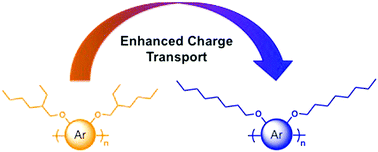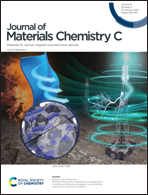Structural effects on the charge transport properties of chemically and electrochemically doped dioxythiophene polymers†
Abstract
We evaluate a set of two 3,4-propylenedioxythiophene (ProDOT) and two acyclic dioxythiophene (AcDOT) homopolymers with each type of XDOT having either branched or linear solubilizing side chains. We show that while altering the structure of the polymer does have an effect on the degree of intermolecular ordering of the polymer film, these as-cast morphologies are not correlated with enhanced charge transport properties. When using linear n-octyl solubilizing side chains rather than branched ethylhexyl chains, we see a multiple order of magnitude increase in the solid-state electrical conductivity for both ProDOT and AcDOT polymers. When using an ammoniumyl-based dopant (Magic Blue) as a chemical oxidant, these polymers show conductivities on the order of 100 S cm−1. In terms of redox properties, linear side chains lower the onset of oxidation by 300 mV and increase the electrochemical conductance. Finally, the polymers substituted with linear side chains have higher ionic mobility implying that these polymers are more effective at transporting both electronic charge carriers and ions through the film.



 Please wait while we load your content...
Please wait while we load your content...